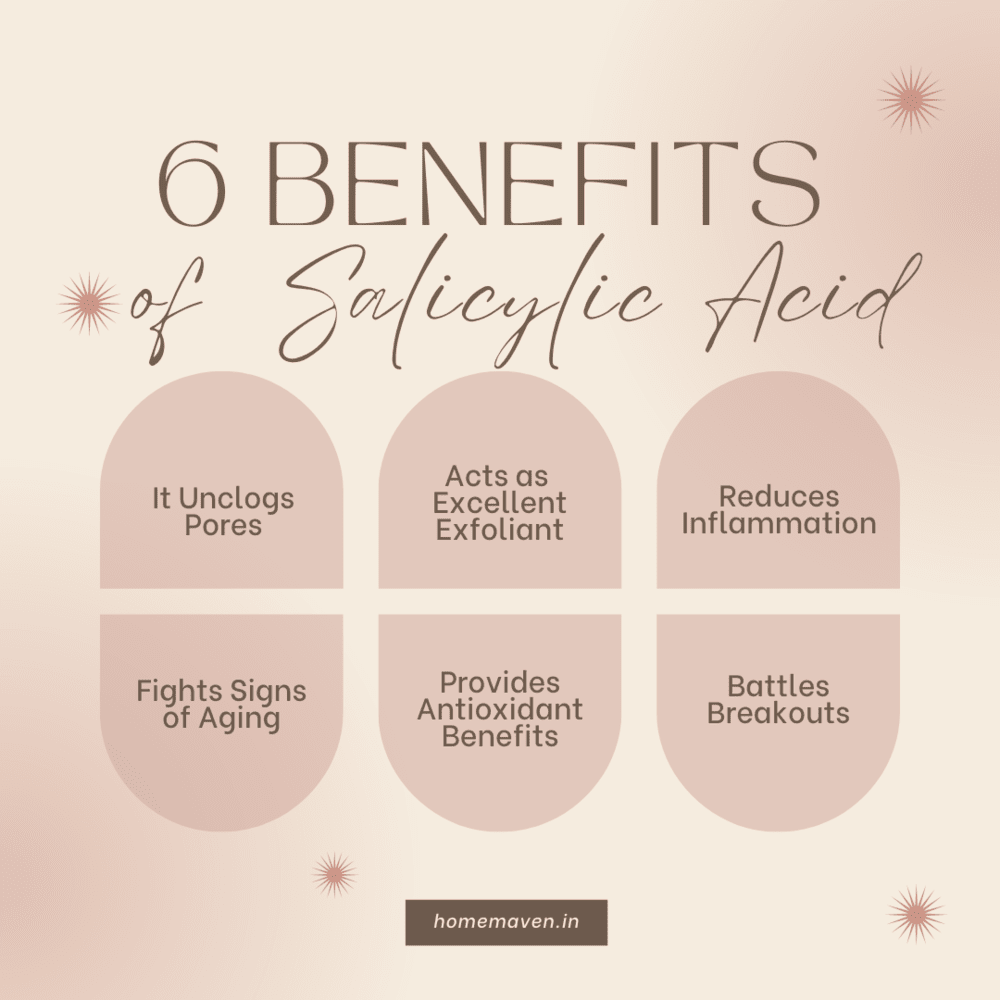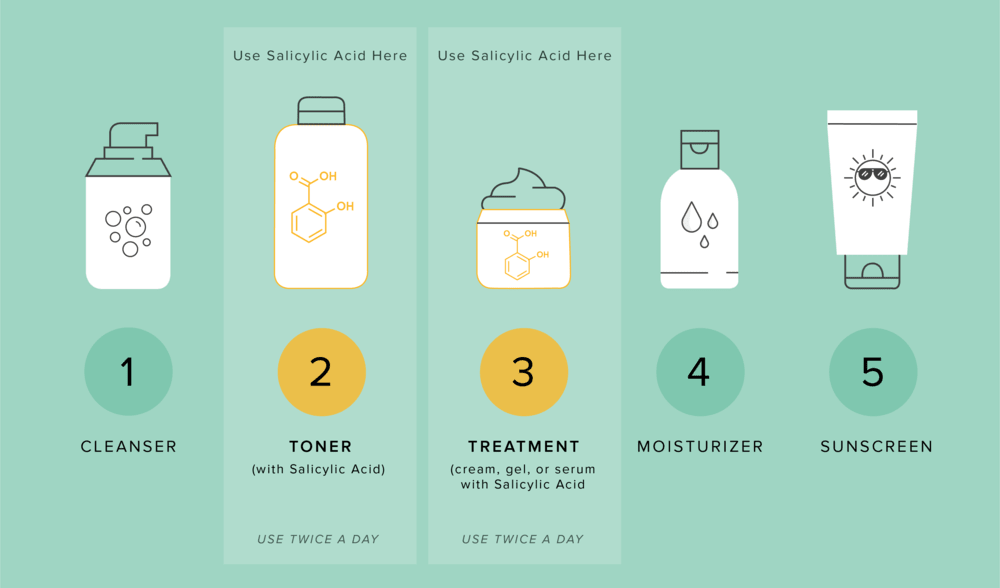Are you looking for a way to keep your skin healthy and glowing? If so, salicylic acid serum could be the perfect solution.
Benefits of Salicylic Acid Serum are immense. Salicylic acid is an incredibly powerful ingredient that can help to treat breakouts, reduce inflammation and improve overall complexion.
In this article, I’ll discuss all the amazing benefits of using a salicylic acid serum on skin.
Salicylic acid has long been used as a natural exfoliant due to its ability to penetrate deep into pores and gently remove dead cells from the surface layer of the skin.
It’s known for calming redness and irritation while balancing oil production, making it ideal for acne-prone and sensitive skin types.
What is Salicylic Acid?
Salicylic acid is a popular skincare ingredient for both treating and preventing common skin conditions. It’s derived from the bark of certain types of trees, such as willow or poplar, and has been used medicinally for centuries to reduce inflammation, treat acne, and exfoliate dead cells on the surface of the skin.
Salicylic acid can also be found in many over-the-counter products ranging from cleansers to moisturizers.
Why Salicylic Acid Serums Should Be Preferred? : Types of Salicylic Acid Products
The most popular types of Salicylic Acid Products are: –
- Creams
Creams are a popular spot treatment option, as they contain low concentrations of this mighty chemical exfoliant that can penetrate the skin’s surface without causing irritation or dryness.
Chemical peels formulated with salicylic acid provide an even stronger dose of exfoliating power – perfect for those looking for a more intensive peel for acne or blotchy skin.
However, since these products contain higher levels of active ingredients, it is important to consult a dermatologist before using them for optimal safety and results.
Instead, Salicylic acid serums offer milder yet effective exfoliating action, making them a great choice if you’re seeking an easy-to-apply, long-term solution to your skincare concerns.
- Lotions
Lotions are another type of salicylic acid product that can be used to help treat acne and improve skin texture. They contain oil-soluble ingredients, such as the active ingredient salicylic acid, which has keratolytic properties and antibacterial properties.
This makes them great for soothing dry, irritated skin while helping to reduce inflammation from blemishes. By combining a moisturizing product with an exfoliating one, you could get maximum benefits from both products in one application.
Having a lotion that contains both these skincare ingredients allows your skin to benefit from their combined powers since it is more easily absorbed into the skin than serums or peels and adding to it, lotions provide hydration without leaving behind any greasy residue on your face; perfect for those who want a lightweight yet effective solution.
- Serums
Serums are yet another type of salicylic acid product that can be used to help treat acne and improve skin texture. However, they differ from lotions as serums do not contain oils or moisturizers; rather, they have a higher concentration of active ingredients such as salicylic acid which make them an ideal choice for those with oily or acne-prone skin.
Serums also work to exfoliate dead skin cells gently while also helping to rebuild the skin barrier. This makes them great for people looking for a gentle topical treatment in their beauty routine without having too much acid in their products.
The serums have a thinner consistency than other products, hence they can easily penetrate the deeper layers of the skin allowing your pores to benefit from all its goodness. Moreover, they have maximum 2% of concentration, whereas chemical peels can contain up to 50% of the concentration.
How Salicylic Acid Serum Work?
Buying Salicylic Acid for Skin? Is salicylic acid good for skin?
Let’s check out the benefits of Salicylic Acid Serum which will clear your queries.
- Unclogs Pores: Salicylic acid helps to break down dirt, oil, and other debris in your pores to keep them clear and reduce inflammation.
- Excellent Exfoliant: One of the main benefits of using salicylic acid on face is its exfoliating abilities. It works by gently removing the buildup of dead skin cells that can lead to clogged pores, acne, and blackheads.
- Reduces Inflammation: One of the important Salicylic acid benefits for skin is that it can help to reduce inflammation caused by acne, soothing irritation and redness.
- Fights Signs of Aging: Salicylic acid can help reduce wrinkles and fine lines, giving your skin a smoother, more youthful appearance.
- Provides Antioxidant Benefits: Salicylic acid helps to protect the skin from free radical damage, reducing the risk of premature aging.
- Battles Breakouts: Lastly, one of the biggest draws to using salicylic acid serum is its ability to fight against breakouts caused by clogged pores or excess sebum production. The chemical properties of this product allow it to penetrate deep into pores and dissolve oil and impurities without drying out your skin too much.

Another Salicylic Acid Serum benefit is gentle on skin. Unlike harsher acids like glycolic or lactic, salicylic acid is much gentler on the skin so it won’t cause any irritation or redness — making it suitable for people with sensitive complexions.
With regular use, you will start seeing Salicylic acid benefits for skin (within 4-6 weeks of treatment). As we move forward, let us examine how these positive results might come at a cost depending on individual usage habits and potential side effects associated with long term use.
Salicylic Acid Side Effects
Although salicylic acid is a key ingredient in many skincare products and an effective acne treatment, it can be a potent ingredient for people with sensitive skin.
Take the case of my friend Jyoti, who had dry and flaky patches on her cheeks due to sun exposure as well as oily and acne-prone skin. She started using a salicylic acid serum twice daily but experienced redness and irritation around her eyes after just one week.
Here are some potential side effects that may occur when using a salicylic acid serum:
- Dryness – Salicylic acid can be drying, so moisturizing regularly is important when incorporating this ingredient into your routine.
- Redness or stinging sensation – This might indicate that you’re overusing the product or have allergies to certain ingredients present in the formula.
- Breakouts – Because of its exfoliating properties, too much salicylic acid can sometimes cause more breakouts instead of clearing them up.
Although regular use of the right amount will ensure maximum benefits from this powerful beneficial ingredient, it’s best to patch-test any new product containing salicylic acid first before applying it all over your face.
If irritation occurs, reduce usage frequency or switch to another product altogether.
How to use Salicylic Acid Serum on Face?
Now that we’ve discussed the potential side effects of salicylic acid, let’s take a look at how to apply it for maximum effectiveness.
It can be used as part of a natural hydration treatment or combined with other ingredients such as vitamin C serum for added benefits.

- Start by washing your face with a mild cleanser and warm water.
- Pat your skin dry with a clean towel.
- Apply a light layer (pea size) of salicylic acid serum to your face.
- Allow the serum to absorb into your skin for a few minutes.
- Follow up with your regular moisturizer or sunscreen.
- Repeat the process once or twice per day, as needed.
The perfect product should have both short-term and long-term benefits so look out for formulas that replenish moisture levels while providing anti-ageing properties.
With this knowledge in hand, you now know what steps to take when choosing and applying a salicylic acid serum – feel free to experiment until you find the perfect balance of nourishing ingredients tailored just right for your individual needs.
When Should We Use Salicylic Acid Serum?
Salicylic acid serum is best used after cleansing and toning, but before moisturizing. This allows it to penetrate the skin better and be more effective. It can be used once or twice per week in the evening preferably, or both depending on the severity of your skin issues.
Conclusion
Salicylic acid serum is a powerhouse skin care product. It’s an effective way to tackle acne, reduce inflammation and even out the appearance of your complexion.
I recommend using salicylic acid serums sparingly to experience its powerful benefits without running into any potential side effects.
Using alliteration for emphasis, remember that when it comes to skincare products containing this potent ingredient—less is more!
Also read: Mysore Sandal Soap Benefits
Frequently Asked Questions
Is salicylic acid good for face?
Yes, salicylic acid is often used in skincare products to treat acne, reduce inflammation, and exfoliate the skin. It is suitable for all skin types, so it can be used on the face.
Is salicylic acid good for oily skin?
Yes, salicylic acid is often recommended for oily skin. It helps to remove excess oil from the skin and reduces the risk of acne and other skin problems. It can also help reduce the appearance of large pores.
Does salicylic acid darken skin?
No, salicylic acid should not darken the skin. In fact, it is used to lighten the appearance of dark spots, acne scars, and other discolored patches on the skin.
Is salicylic acid good for sensitive skin?
Yes, salicylic acid is generally considered safe for sensitive skin. It is a gentle exfoliant that can help reduce the appearance of blemishes and smooth out the skin’s texture. However, it is important to start slowly with a low concentration of salicylic acid and increase it gradually as your skin adjusts. It is also important to use a moisturizer afterward to help protect and nourish the skin.







